5
BANG-BANG
I lament with sorrow and cry because the boys
are finished. The boys are finished
Traditional Acholi funeral song

We were all white, middle-class young men, but we
went to those unfamiliar black townships for widely differing
reasons and with contrasting approaches; over the years, we would
find common ground in our shared experiences and develop
friendships.
Ken, unlike the rest of us, was not at ease with
black people, and in the beginning I avoided working with him too
much because of that. Not that I can recall Ken ever saying
anything racist: it was just a difference in response, in empathy.
Perhaps he was as uncomfortable with me and my open support for
blacks in a country where identity was deeply, indelibly based on
the colour of a man’s skin and how tight his hair curled. But Ken’s
experiences as a photographer slowly changed his attitudes and had
rid him of that native, unthinking racism.
While Ken was undergoing that process, Joao and he
became close friends. The hours spent processing and printing
pictures in each other’s company created a lot of time to learn
about each other. They mostly just chatted or gossiped, but the
claustrophobic processing cubbyholes at The Star were ideal
for intimacies and sharing secrets. It was in Ken’s
cubicle that he showed Joao the contents of a photo-paper box he
treasured. Inside were pictures of a little girl: Tabitha, his
daughter from a previous relationship. Ken’s wife, Monica, had
forbidden him to see his daughter and had even made him promise in
writing to not visit the child. For someone who worked so hard to
keep things in hand, there were parts of Ken’s life that were
definitely out of control. Monica’s jealousy was so intense that
Ken would ask Joao and others at the newspaper to lie to her when
he went to see Tabitha. Ken hid those pictures, fearing Monica
would destroy them if she ever found them.
On Joao’s birthday in 1992, he was in his darkroom
cubicle processing film when Ken came in to see how the job had
gone. After some time, grinning broadly, Ken handed him a large
brown envelope. Joao opened it, expecting a card, but instead it
was a black-and-white photograph of a train smash and written on
the bottom of the picture was ‘Happy birthday Joao!!’ Joao wondered
why Ken had given him that picture. ‘That’s what happened the day
you were born!’ Ken explained. He had gone to the newspaper
archives to see what had been on the front page on 9 August 1966,
unearthed the original negative and made an 8’ by 10’ print. ‘A lot
of people die?’ Joao asked. ‘Lots,’ replied Ken, who had been born
on Valentine’s Day. ‘On my birthday, they had some girl with
flowers; on yours there has to be a disaster!’
By 1992, Ken had turned The Star’s photo
department around. That year Joao won the national Press
Photographer’s award, Ken was runner-up and The Star
photographers dominated all the categories. It was through Joao
that I got to know Ken better. There were individual friendships
between the four of us, as well as a growing common bond. Our
girlfriends and wives became friends, and we would get together for
meals and to discuss and edit the pictures when one of us had done
a big story.
When there was a lot of violence, we would team up
for ‘dawn patrols’ - waking before dawn to be in the townships by
first light. It was a ritual that we had each done singly at first
and then later two or three of us would sometimes cruise together.
The companionship meant I did not feel so alone when the alarm
jerked me awake to face
the next day of witnessing the violence. Sometimes when the days
had been really bad I would wake seconds before the alarm and try
to find excuses for staying in that warm bed, but the thought that
the others were waiting somewhere would help me to get up.





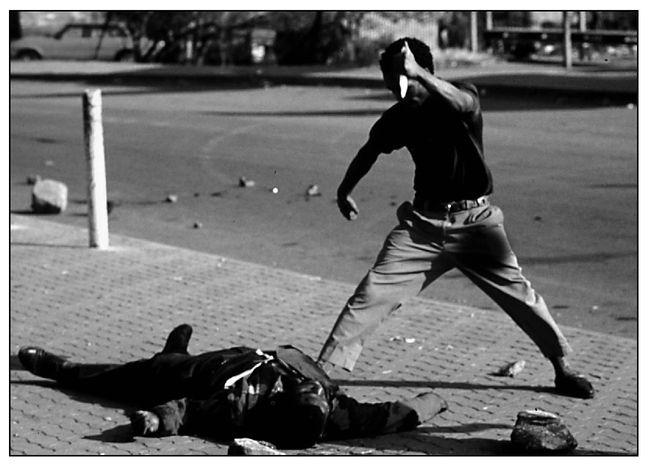
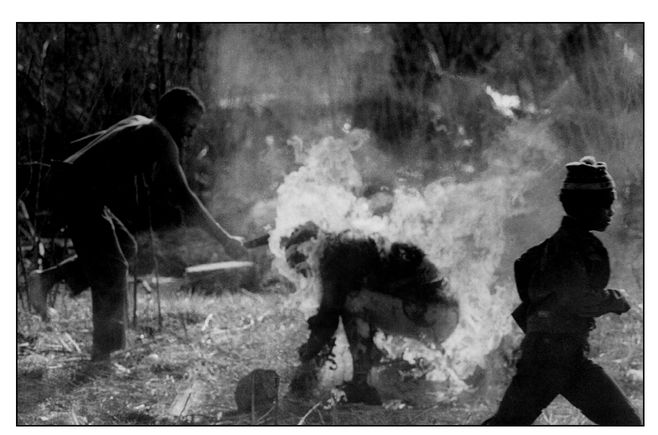


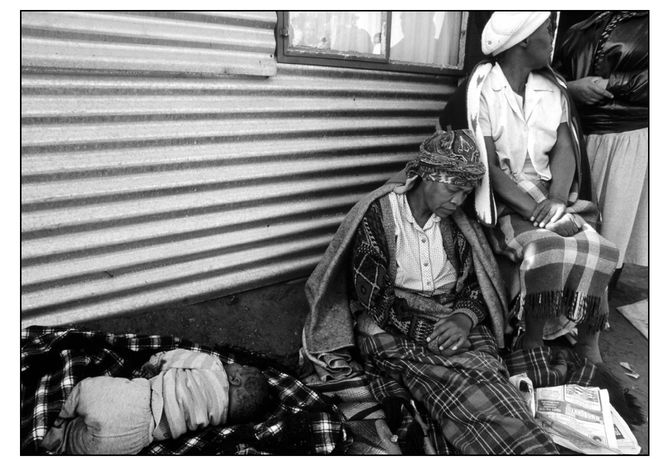

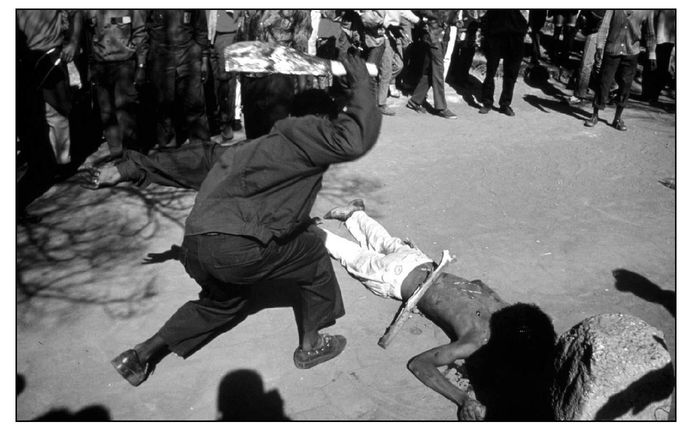
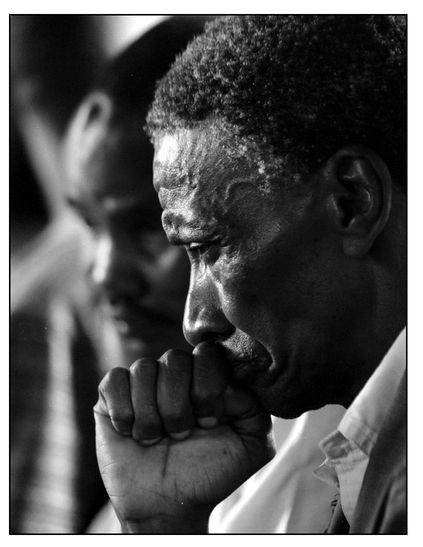

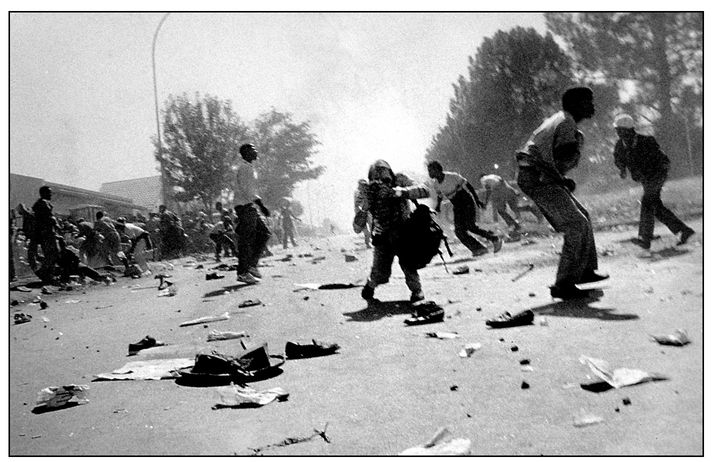


A girl leads her younger sister to safety as an
impi, or regiment, of Inkatha-supporting Zulu warriors moves down
Khumalo Street, Thokoza, at the start of the Hostel War, August
1990. Ken would later be killed in this same street, four years
later. (Ken Oosterbroek / The Star)

Nancefield Hostel, Soweto, 17 August, 1990. A
group of Inkatha-supporting Zulu hostel dwellers kill a man they
suspect of being a Xhosa - understood by the attackers to be
synonymous with the ANC. It turned out that he was an ethnic Pondo
of undetermined political allegiance. (Greg Marinovich)

Khumalo Street, Thokoza, December 1990. A man
laughs towards the camera as he passes a group of female Inkatha
supporters beating an unidentified woman. The severely injured
woman was later picked up by police, but it is not known if she
survived. (Joao Silva)

ANC-supporting Xhosa warriors receive magic potion
or intelezi from a sangoma at ‘the mountain’ in
Bekkersdal township, west of Johannesburg, 1993. (Kevin
Carter/Corbis Sygma)

Inhlazane, Soweto, 15 September, 1990. An ANC
supporter prepares to plunge a knife into Lindsaye Tshabalala, a
suspected Inkatha supporter, during clashes at the start of the
Hostel War. (Greg Marinovich)

Inhlazane, Soweto, 15 September, 1990. An ANC
supporter hacks at a burning Lindsaye Tshabalala as a young boy
flees. This was one of a series of pictures that won the Pulitzer
Prize for Spot News in 1990. (Greg Marinovich)

Maki and Sandy ‘Tarzan’ Rapoo explain how their
nephew, Johannes, was shot dead by police in their Meadowlands Zone
1 suburb of Soweto, June 1992. They were in the kitchen of the
house on Bakwena Street, where they had previously suffered the
loss of Sandy’s younger brother, Stanley. (Greg Marinovich)

Maki Rapoo leads her brother-in-law, Lucas, out
into the yard of the family home on Bakwena Street to do a
traditional dance during his wedding reception in 1996. (Greg
Marinovich)

The maternal aunt of Aaron Mathope grieves next to
the nine-month-old infant’s corpse after he was hacked to death by
Inkatha attackers, aided by police, in Boipatong Township, 18 June,
1992. 45 people were killed. One of the Inkatha attackers’ leaders
later explained the killing of Aaron thus: ‘You must remember that
a snake gives birth to a snake.’ (Greg Marinovich)

Policemen open fire on an unarmed crowd of
Boipatong residents who had wanted access to a man shot dead
earlier by police after President FW de Klerk was chased from the
township on 20 June, 1992, days after the massacre. There were
several deaths and injuries. Police and the government denied this
incident occurred, saying residents and journalists had fabricated
the casualties. (Greg Marinovich)

A resident of Boipatong hacks at the body of a
Zulu man suspected of being an Inkatha member who had taken part in
the Boipatong Massacre. He was later burned. (Joao Silva)

Daniel Sebolai, 64, who lost his wife and son in
the Boipatong Massacre, holds back the tears during a workshop on
issues related to the Truth & Reconciliation Commission in
Sebokeng, 28 October, 1998. Next to him is Boy Samuel Makgome, 48,
who lost his eye during an attack on a train by Inkatha Freedom
Party members in 1992. Hundreds of victims who did not find
sufficient or any redress from the commission are counselled and
advised of their rights by nongovernmental self-help groups made up
of human-rights victims. (Greg Marinovich)

An ANC mourner takes evasive action from police
gunfire during violent clashes at the funeral of Communist Party
and ANC military leader, Chris Hani, 19 April, 1993. Hani was
assassinated by white extremists. An election date for one year
later was set soon afterwards. (Greg Marinovich)

Kevin Carter aims his camera to take a picture of
Ken Oosterbroek as Soweto residents flee police gunfire outside the
Protea police station where they had been protesting after Chris
Hani was assassinated by right-wing whites, April 1993. (Ken
Oosterbroek / The Star)
From 1991 to 1993, South African political players
were embroiled in protracted negotiations towards a transition to
the ‘New South Africa’, and the ongoing violence was being used as
a negotiating tool. It was impossible not to notice how the number
of inexplicable massacres and attacks surged whenever the talks
were at a critical stage. Even though we each in our own way were
deeply motivated by the story, pictures and politics, cash also had
its part in getting us up before the sun. The dawn was the
transition between the chaos of the night and the occasional order
of day - when the police would come in to collect the bodies.
I had become known as a conflict photographer. I
could ask for assignments to almost any place, as long as people
were killing each other. But it had taken me a while to learn how
to make use of that reputation. When I had gone to New York in
August of 1991 to collect the Pulitzer, I had asked if I had to
wear a tux to the ceremony, not knowing that tuxes are not worn to
lunchtime affairs. I also naïvely thought that the award would be a
great opportunity to say something about what was happening back
home. I spent days working on a speech and it was in my jacket
pocket when my name was called and I walked up to the dias at
Columbia University. But all the man did was shake my hand and give
me a little crystal paperweight with Mr Pulitzer’s image engraved
on it before ushering me away.
The other winners received their awards with equal
haste and then there was a luncheon. It was the 75th anniversary of
the prize and all living winners had been invited. It was an
absurdly ideal place to establish contacts with many of the most
important picture editors and the world’s greatest photographers. I
made a wan effort to meet people, but I was in no frame of mind to
do it effectively and left soon afterwards.
Despite my ineptitude in handling the business side
of photography
and in marketing myself, by late September of 1991 I had convinced
the AP to assign me to cover the war in Croatia, and within days I
was in the front-line village of Nustar. It was autumn, cold and
wet, and the roads had been churned into muddy trails by the tanks.
It was my first time in a ‘real war’ with tanks, artillery and
machine-guns. I had no clue of what was reasonably safe and what
was insane, yet somehow I survived those first weeks without
getting myself or anyone else killed. I found that I liked war.
There was a peculiar, liberating excitement in taking cover from an
artillery barrage in a woodshed that offered no protection at all.
Two other journalists shared that particular woodshed with me: one
was a young British photographer called Paul Jenks, who huddled in
a steel wheelbarrow because it made him feel safer as the massive
detonation of nearby shells mingled with the scream of others
passing overhead. He would be killed months later by a Croat
sniper’s bullet: Paul had come too close to discovering the cause
of the death of another journalist who had been strangled by a
member of a motley unit of international volunteers to the Croat
army. My other companion was Heidi Rinke, an Austrian journalist
with long black hair, beautiful green eyes and a wicked sense of
humour. I lent her my flak jacket as she did not have one and so
began a romance that would keep us warm through the long winter
months of covering the Serbo-Croat war.
Because of my Croat parentage, I spoke a passable
pidgin Serbo-Croat and this sometimes gained me good access. So, in
December of 1991, Heidi and I were the only journalists
accompanying a troop of Croatian soldiers as they took village
after village in the Papuk mountains. The Croats met only token
resistance from geriatric villagers firing old hunting rifles at
them, since the Yugoslav army and the Serb militia had already
retreated, having seemingly decided that the area was bound to be
lost sooner or later. It was eerie to see house after house burst
into flames as we advanced on foot. In addition to putting Serb
homes to the torch, many of the Croat soldiers were looting
everything they could find, especially the local plum moonshine,
slivovic. They also murdered many of the old folk who had been left
behind. Deeper in the mountains, a soldier and I helped an old lady
to the safety of her
neighbour’s farmhouse after her house had been torched. The Croat
commander, a decent enough man in charge of a bunch of murderous
drunks, promised that the women would be safe. A few hours later, I
stopped by to check on them, but the barn and house had been burnt
out. My heart was in my mouth as I searched for the two women. I
found only one and she was lying dead in the frozen mud.
In another hamlet, on another day, a
conscience-stricken Croat soldier whispered to me that there was an
old man still alive in one of the partially burnt farmhouses. Heidi
and I tried to be nonchalant as we walked up the drive where blood
spilled on the mud gave urgency to our search. We found nothing in
the house, not even a corpse. I came back down to the road and
surreptitiously asked the soldier where the wounded man was; he was
terrified that his comrades would see him talking to me and
whispered, ‘In the barn.’ I went back up past the blood and to the
wooden barn, but saw only piles of hay. I started pulling at it,
prepared for the worst; but I still got a fright when confronted by
the grey, bloodless and unshaven face of an old man at the bottom
of the pile. He was alive, but in a bad way. He had been shot and
left under the hay to die. I tried to tell him to be calm, that we
would get help. While Heidi was staunching the old peasant’s
bleeding leg, I bent closer to hear what he was saying. I had my
ear next to his mouth before I understood what it was that he kept
repeating: ‘Don’t let the pigs eat my feet, don’t let the pigs eat
my feet!’ It was not a crazy fear - pigs will eat anything, and on
a few occasions I had seen pigs feeding off human corpses.
It was a strange war. One day I discovered a
white-haired Serb lying dead in a ditch with his ears cut off. An
unshaven, grinning Croat soldier with rotten teeth came up to me as
I was taking pictures and he gleefully told me that he had killed
and mutilated the old villager. His commander had a standing offer
that anyone who brought him a pair of Serb ears could go home for
four days. My Croatian surname allowed me to witness one side of
the intimate brutalities of the civil war, but it precluded me from
seeing the even greater toll of Serb atrocities up close.
Despite the horrors and my ancestral links to the
country, the war did not have the same emotional impact on me as
the events I had witnessed in South Africa - it was not my country
and not my struggle. I was definitely there as a foreign
journalist. In February of 1992, I returned to South Africa with
Heidi. We lived together in the house I’d bought shortly after
winning the Pulitzer. I had taken out a mortgage in order to buy
it, as for the first time in my life I felt financially secure,
after years of living hand-to-mouth. I was perpetually amazed by
the turnaround in my circumstances - just one year previously I had
been on the run from the police, but I now reckoned that there
would be an outcry if they arrested South Africa’s only Pulitzer
Prize-winner. I began to use my real name as a by-line. But in
reality, the environment was changing, and ‘crimes’ such as mine
were being ignored, as were draft-dodgers and conscientious
objectors - whereas they had previously been hunted to ensure there
was no ‘moral rot’ among whites. But even the Pulitzer could not
change the effect that witnessing such searing events had had on
me; on my return I found that I was almost immediately emotionally
and politically ensnared by the events in South Africa. Unlike in
the former Yugoslavia, I could not keep a distance from this story,
nor from the people I photographed.
I remember a Sunday morning just weeks after coming
back. In the street outside my house I was cleaning my car. Several
neighbours also had hosepipes and buckets out as they cleaned and
polished their cars - a Sunday ritual in my working-class
neighbourhood. We greeted each other - they recognized me from
interviews on television and in the papers. What they did not know
was that I was not getting the car spruced up for the weekend, but
that I was grimly trying to wash someone’s brains out of the cloth
upholstery of my back seat. The previous afternoon, while most of
South Africa was grilling meat on the braai or watching sport on
television, I had been racing through the streets of Soweto trying
to get to the hospital before the rasping, noisy breathing of the
young man lying on my back seat ceased. The comrade’s girlfriend
cradled his head in her lap and Heidi, sitting alongside, was
telling me not to bother speeding, that it would make no
difference. Brain-matter and fluid bubbled freely out of a gunshot
wound in his head and he was not going to make it. At the hospital
they pronounced him dead.
So, despite the cheery greetings from my
neighbours, I resented them cleaning simple street dirt off their
cars. This was something that I could not explain to them, nor to
anyone else. It was as if they were occupying a different planet to
me. It was precisely this that helped draw Joao, Ken, Kevin and me
close to each other. When we tried to discuss those little telling
details from incidents in the townships with people who had never
experienced them, the usual response was either disgust or
uncomprehending stares. We could only really talk about these
matters to each other. Kevin had once written about his feelings on
photography and covering conflict in an article which expressed
thoughts that we had all, on occasion, shared: ‘I suffer depression
from what I see and experience nightmares. I feel alienated from
“normal” people, including my family. I find myself unable to
relate to or engage in frivolous conversation. The shutters come
down and I recede into a dark place with dark images of blood and
death in godforsaken dusty places.’
It was from this sense of being outsiders from the
society we had grown up in, and of being insiders to an arcane
world, that we developed into a circle of friends prompting a local
lifestyle magazine, Living, to dub some of us ‘the Bang-Bang
Paparazzi’ in a 1992 article. Joao and I were so offended by the
word ‘paparazzi’ that we persuaded the editor of the magazine-a
friend called Chris Marais - to change it to ‘the Bang-Bang Club’
when he wrote a follow-up piece that was about the four of us. We
were a little embarrassed by the name and its implications, but we
did appreciate being acknowledged for what we were doing. No matter
what they called us, we liked the credit.
Articles like the Bang-Bang Club piece made us
minor celebrities in media circles. As a result, several young
South African photographers were motivated to try their hand at
documenting the violence. One of these was a young man called Gary
Bernard, who had always wanted to be a professional
news-photographer. He kept seeing our pictures in the
papers and he eventually signed up at a non-profit photographic
workshop, where he attended classes in the evening while working as
a printer during the day. Gary’s decision to be a news-photographer
coincided with Ken’s becoming The Star’s chief photographer.
From being a notoriously self-absorbed egotist who cared only for
his career and awards, Ken had become a champion of aspiring
photojournalists. Gary was one of a group of interns Ken had taken
on at The Star in a programme to recruit talented young
photographers from the workshop into the newspaper. Gary would go
out with us to learn the ropes and he became a friend. He wanted to
be a bang-bang photographer. Despite his desire to cover conflict,
Gary was far too sensitive to deal with the violence, but he kept
his feelings to himself. On the surface he seemed to handle the
emotional aspect of the violence OK. We had no idea about his
dysfunctional family past and how he blamed himself for not having
been around when his father committed suicide. Sometimes I would
catch myself looking at Gary and wondering what was going on in his
mind, but I was too preoccupied to follow up on any of the small
signs that might have indicated a real problem. It was only later
that we understood the full effect that the accumulated trauma was
having on him.
The stress from what we were seeing and the at
times callous act of taking pictures was making an impact on all of
us. Ken was waking up in the middle of the night sweating and
screaming about things he had seen. Joao had become quiet and
withdrawn, and I sank into a deep depression that I only clawed my
way out of years later. Kevin was the most outwardly affected and
that meant that life as his friend could be demanding. He seemed to
have no borders, no emotional boundaries - everything that happened
to him would penetrate his very being and he let all that was
inside him just pour on out. The highs of boundless energy and
infectious joy would inevitably crash and then we would get the
despondent midnight calls. Joao, Ken and I all had our turns at
spending hours talking to a weeping Kevin until he had been soothed
or grown exhausted enough to sleep. But through it all, Kevin had a
way about him, an openness to pain, a generosity with his time and
affection which meant it was easy to overlook those lapses and
become even closer friends.
Maybe it was because his emotions were always right
up front that Kevin was the most candid of us all about the effect
that covering the violence was having on him. He was having a beer
at a pub opposite The Star one Saturday afternoon when Joao
came in after covering an uneventful political funeral. They
listened to a radio report that three people had died in clashes
following the burial. Joao wanted to go back to the township, but
Kevin said it was getting dark and talked him out of the idea.
After several more beers, Kevin recounted a recurrent nightmare
that was plaguing his sleep. In the dream, he was near death, lying
on the ground, crucified to a wooden beam, unable to move. A
television camera with a massive lens zoomed closer and closer in
on his face, until Kevin would wake up screaming. Kevin thought
that the dream meant it might be time to leave photography.
When Kevin told me about the same nightmare some
time later, he described the feelings of helplessness, the anger,
the fear he lived though in that dream. It was all that he imagined
our subjects must feel towards us in their last moments as we
documented their deaths. The dream had variations: sometimes Kevin
was the photographer, not the victim, and in that version, the
‘dead’ man would roll over and grab him by the ankle, holding him
captive with bloody hands.
Some weeks previously, in a lawless Sowetan shanty
town called Chicken Farm, Kevin and I had been following armed
policemen as they ran through the shacks, plunging downhill along
rough tracks muddy with raw sewage. At a clearing near a stream, we
saw a woman in rural Zulu dress wailing in grief, her hands
clutching her head. In front of her, a middle-aged man was lying on
his back, his arms stretched out on either side of him along a
thick wooden beam. It looked as if he had been crucified. His
earlobes, pierced and enlarged in the traditional Zulu fashion,
were filled with blood from several head wounds. There is no
question that a professional thrill ran through me: it was a scene
that could be an icon of the civil war. Kevin and I descended on
the corpse, but once we started to photograph, I found
myself struggling and failing to capture this image of the
crucifixion properly. I was unnerved, jittery, my hands were
shaking involuntarily. Perhaps it was because of the woman wailing
or memories of childhood religion, of Christ on the cross. I looked
at Kevin; he looked stunned. Suddenly the corpse groaned and rolled
on to its side. We leaped back in terror - we had been so certain
he was dead. I will never forget that moment of horror, but unlike
Kevin, I had no nightmares; at least none that I could recall in my
waking hours.
An American consultant hired in November of 1992 to
revamp the look of The Star was convinced that Joao was
suffering from posttraumatic stress syndrome, similar to what he’d
seen among photographers in Vietnam. Management agreed and, despite
protests from both Ken and Joao, he was told to stop going to the
townships. South Africa’s isolation from the world during the
apartheid years meant that any foreigner was automatically granted
expert status and respect, often beyond their due. Joao was
assigned to cover the effect of pollution on a pond in a wealthy
white suburb of Johannesburg. While walking disconsolately around
the sad pond, he noticed a duck waddling unsteadily towards him.
The duck collapsed and died at his feet. Back at the newspaper, he
printed the series as a montage with the mischievous caption
‘Going, going, gone’ and presented it to the photo desk. The
consultant was appalled and urged the newspaper to get Joao
psychological help.
Late that same night, a ‘press alert’ came across
on the pager. An entire family had been in slain in Sebokeng, a
sprawling black township south of Johannesburg that was plagued by
mysterious killings and massacres and drive-by shootings. Kevin and
Joao exchanged calls with Heidi and me, and despite the heavy rain
and our anxiety about the fact that it was well after dark, we
decided to go. The common wisdom among journalists was to never
enter conflict zones after dark: things were different at night;
people behaved without restraint. And we would have to use our
flashes to get pictures - risky as the bright light going off
spooked people and could attract gunfire.
The rain was bucketing down as we raced south in
Kevin’s little
pick-up. Heidi and I huddled against the cold in the fibreglass
canopy on the back, bracing against each other as the car
aquaplaned unpredictably every time it hit a patch of standing
water on the road. We were uncertain about the wisdom of the foray:
rumours of white agents provocateurs taking part in killings in the
black townships meant that whites were increasingly treated with
hostility. Sebokeng was probably the most dangerous township for
journalists to work in, but we were determined to try to expose
what was going on. When we got there, the dark streets were
deserted. We had no way of finding the house as there were few
street signs and residents had taken to painting over their house
numbers for fear of being targeted for attack. The killings were so
indiscriminate that people had devised convoluted theories as to
who might be the next target-a situation which made wandering
strangers seem to be a potential threat.
Usually we could ask people for directions or
follow our noses to the right place, but the rain and the fear of
being out at night meant that there was no one around to help. We
started to regret our decision: to the armed self-defence unit
members that kept watch, we must have looked like killers
ourselves, cruising around looking for victims. We crept fearfully
along the main streets, hoping to stumble on to the right house,
until we saw a police armoured vehicle lumbering along, the deep
growl of its engine breaking the silence. They were surprised to
see whites there, but agreed to let us follow them to the house.
While we waited for the detectives to finish their investigation,
we found shelter from the wet with the survivors in a back room.
The rain drummed on the tin roof, leaking through holes. Under the
dim glow of a naked light-bulb, 21-year-old Jeremiah Zwane related
how two men had burst through the front door and thrown a tear-gas
canister into the room, then gone from room to room shooting
everyone they found. His father and his brother had been gunned
down in one bedroom. Jeremiah’s sister, Aubrey, just seven years
old, had tried in vain to hide in her parent’ bedroom closet. She
lay on her back in a pool of blood alongside her dead mother. Shot
in the face and chest, her little body was a deeply shocking sight
even after the many gruesome images
we had photographed over the previous two years. A visiting
teenage cousin had been shot dead in the lounge. Another teenage
sister had died on the way to hospital, but her two-day-old baby
had somehow survived the attack unhurt. The house looked like a
scene in a horror movie, but this was real. The smell of blood was
heavy in the damp air.
The four of us were the only journalists out in
Sebokeng that night, despite the fact that every news organization
and most journalists had received the message of the killing on
their pagers as we had. We were convinced that the only way to stop
such killing was to show what those deaths looked like, what those
daily body counts actually meant.
The Star, which had suggested Joao lay off
covering township violence, ran the story he had reported and two
pictures, one on the front page. I transmitted pictures to the AP
and The New York Times. Without our pictures, the only
source of information on the massacre would have been spokesmen for
the police and the political parties. Editors from most domestic
and foreign media organizations still took police reports as
factual even though the police were clearly a part of the problem.
I remember many infuriating discussions with Renfrew, who was then
still the AP bureau chief, about police and military involvement in
the killings - he would patronizingly accuse me of being
politically biased and naïve, but the AP and almost every other
news organization chose to believe the government’s propaganda. The
public would have been given information about yet another massacre
from the people who were actually involved in many of the killings,
as would be proved years later. It seemed that the international
and domestic public were all too ready to believe that people who
sometimes dressed in skins and could not speak English properly
must be barbaric, while the white politicians and officials who
spoke so logically and kept the trains running on time could not
possibly be implicated in the murders. And yet despite our attempts
to tell the truth, through our reporting and in our captions, our
pictures played an unwitting part in the deception - our images
from Sebokeng that night showed horribly dead black people and
white policemen in uniform taking the bodies away, investigating
their deaths. The impression was
of the police helping the victims. Our pictures could not show
that they had arrived hours after the emergency calls for help:
they could not show the absolute certainty of the survivors that
security forces had been involved in the attack.